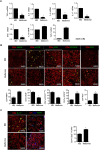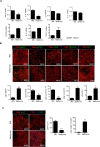Metformin Ameliorates Inflammatory Bowel Disease by Suppression of the STAT3 Signaling Pathway and Regulation of the between Th17/Treg Balance
- PMID: 26360050
- PMCID: PMC4567351
- DOI: 10.1371/journal.pone.0135858
Metformin Ameliorates Inflammatory Bowel Disease by Suppression of the STAT3 Signaling Pathway and Regulation of the between Th17/Treg Balance
Abstract
Objective: Metformin is used to treat type 2 diabetes. We sought to determine whether metformin reduces inflammation, by regulating p-signal transducer and activator of transcription 3 (STAT3) expression and T-helper 17 (Th17) cell proliferation, in a mouse model of inflammatory bowel disease (IBD).
Methods: IBD mice were administered metformin for 16 days and their tissues were analyzed. AMP-activated protein kinase (AMPK), the mammalian target of rapamycin (mTOR), p-STAT3 and p-STAT5 in the spleen and lymph nodes were detected using immunohistochemistry and confocal microscopy. Gene expression was determined using quantitative PCR assays, and protein expression levels were measured using western blotting and enzyme-linked immunosorbent assays. Human HT-29 cell proliferation was evaluated using MTT assays.
Results: Metformin reduced disease activity index scores and inhibited weight loss. Metformin also decreased the colonic histological score and inflammatory mediators and increased colon lengths increased. Treatment with metformin inhibited the expression of interleukin (IL)-17, p-STAT3, and p-mTOR. In contrast, metformin treatment increased expression levels of p-AMPK and Foxp3. In addition, expression of inflammatory cytokines decreased in a dose-dependent manner in inflamed human HT-29 cells cultured with metformin at various concentrations.
Conclusions: Metformin attenuates IBD severity and reduces inflammation through the inhibition of p-STAT3 and IL-17 expression. Our results have increased our understanding of this chronic inflammatory disease, and support the strategy of using p-STAT3 inhibitors to treat IBD.
Conflict of interest statement
Figures





References
-
- Baumgart DC, Sandborn WJ. Inflammatory bowel disease: clinical aspects and established and evolving therapies. Lancet May 12; 369(9573). - PubMed
-
- Wruck CJ, Fragoulis A, Gurzynski A, Brandenburg LO, Kan YW, Chan K, et al. Role of oxidative stress in rheumatoid arthritis: insights from the Nrf2-knockout mice. Ann Rheum Dis May;70(5). - PubMed
Publication types
MeSH terms
Substances
LinkOut - more resources
Full Text Sources
Other Literature Sources
Miscellaneous

